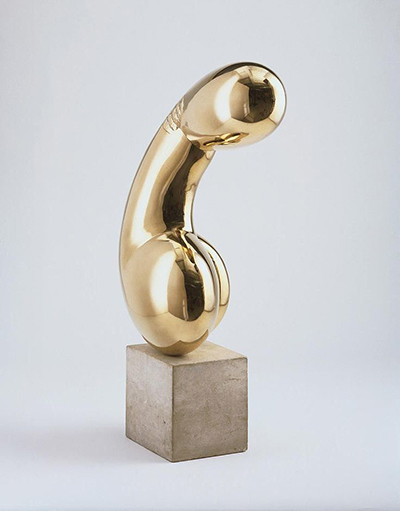Ever since it was revealed to the world at the 1920 Salon des Indépendants in Paris, Constantin Brancusi's sculpture Princess X has been the subject of controversy and opposing interpretations.
Intended by the artist to be a rendering of the French princess, Marie Bonaparte, the sculpture was immediately taken off display when police intervened, determining that the phallic form of the piece was obscene. Crafted in 1915, Brancusi insisted that the interpretation of the police and others was a misunderstanding. Appearing somewhat futuristic in its day, Princess X is polished bronze just over two feet high mounted on a limestone base. Dismissing any claims that the work is masculine and intended to represent a phallus, Brancusi's sculpture is an abstract interpretation of the female form. Viewed with the feminine in mind, other observers might see a woman's bust and neck leading up toward her head, which is craning down to gaze at her own reflection in a mirror, as represented by the sculpture's highly polished surface.
Throughout his career as a sculptor, Brancusi would be frequently misunderstood in his efforts to create art that adhered to his philosophy of interpreting "the idea, the essence of things" as opposed to literal appearance. His later work, Bird in Space, was mired in legal controversy when it became the subject of court case relating to a dispute regarding duty tax when it passed through U.S. customs on its way to an exhibit at the Brummer Gallery in New York City. What the judges of the court had to determine was, is Bird in Space art, or simply a piece of metal? The fact that the sculpture did not appear to resemble the body of an actual bird ignited confusion among the customs officers. However, in the end, Brancusi was successful and Bird in Flight was admitted into the U.S. under free entry as a work of fine art.
Other works by Brancusi such as Torso of a Young Man or Fish have also fallen to oversimplification, but like Princess X, these sculptures are prone to misinterpretation without context, or lacking a willingness on the part of the observer to view the work as resembling an idea or sense of beauty without being a literal depiction of a natural or living thing. In essence, to view things as Brancusi intended: as representative of their "inner hidden reality." Princess X is currently held at the Philadelphia Museum Art. This sculpture, along with several others by Constantin Brancusi greatly impacted the Minimalist art movement of the 1960s and later sculptors such as Barbara Hepworth and Isamu Noguchi.




